Origin PC Shows Off High-End Notebooks and the “Not-a-Steam-Machine” Omega
by Jarred Walton on January 13, 2015 7:00 AM EST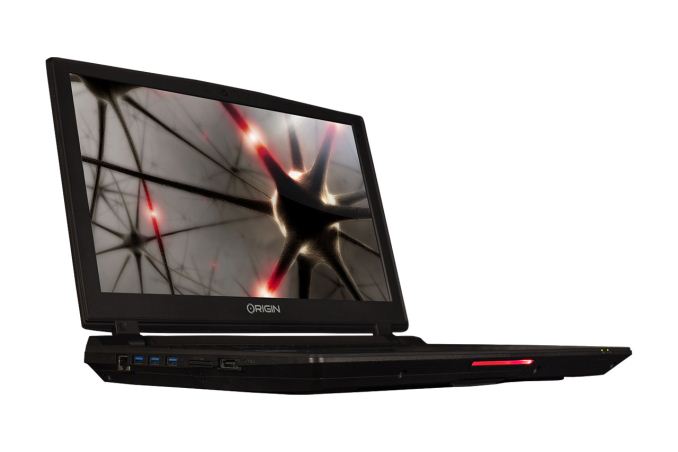
CES now over, which means for a lot of the editors we can finally sit down and write about some of the stuff we saw during the week. If you follow me on Twitter, you were able to see a bunch of the products I looked at in pseudo-real-time, but Tweet limitations mean there’s often far more to be said. So rolling back to last Wednesday, let’s go over my meeting with Origin PC.
This was the first time I was able to go hands on with the new Clevo laptops. The designs have been updated since the last generation, with some minor to moderate tweaks in terms of aesthetics. Perhaps more importantly, they Clevo ditched the awful (IMO) trackpads from the last generation, so there's no "tribal tattoo" this time.
For the mainstream mobile segment, Origin was showing the Clevo P650SG, which they call the EON15-S. It’s the update to the P150SM more or less, with support for up to GTX 980M. This is still running Intel’s HM87 Mobile Haswell platform, but of course standard voltage and quad-core Broadwell hasn’t launched yet so that’s to be expected at the high-end. The CPU is the i7-4720HQ, and the chassis has support for two M.2 SATA drives (or two M.2 PCIe drives) along with two 2.5” drive bays.
Origin also says the laptop has “4K gaming support with 4K Ready external display”; 3K and 4K 15.6” displays are available on the market, but for now it doesn't appear Origin will be offering the EON15-S with those; I believe the included 1080p display was wide viewing angle at least, which is likely sufficient for most users. I didn’t have a lot of time to really get a feel for the laptop, but while the keyboard looks pretty much unchanged the touchpad was much more responsive than the last P157SM that I tested, and it is using a Synaptics touchpad. The new EON15-S is also 36% thinner (1.13”) and 25% lighter (5.5 lbs.) than the previous model, which is a welcome change.
For those who are looking for extreme performance, Origin PC has two new notebooks that have desktop CPUs, including support for the Devil's Canyon i7-4790K. Origin calls these the 15.6” EON15-X and the 17.3” EON17-X, and they use the Clevo P750ZM and P770ZM, respectively. Overclocking is apparently supported, but only up to 4.5 gigahertz – though that is on all four CPU cores. Of course battery life will take a hit, with or without overclocking, so these are very much transportable laptops rather than something that you could use unplugged for a long period of time.
Other features are similar to the P650SG: dual M.2 PCIe drives with dual 2.5” drives for HDD/SDD use. The laptops all support four SO-DIMMs for up to 32GB RAM, and Origin plans to ship 1080p IPS displays in these systems (though it might take a bit longer to get in sufficient supply of the 17.3” IPS displays; the model they showed was still using a TN panel). Also note that all three models have dropped support for optical drives, so if you need an optical drive you’ll have to look at other options. The EON15-X measures 1.4” thick and weighs 7.49 lbs. so it’s not exactly light, but it is a reduction compared to the previous model. EON17-X meanwhile sees some larger changes, reducing the thickness by 37.5% (1.52” thick now) and it weighs 8.59 lbs. All of the EON notebooks also support full color configurable RGB zoned backlighting.
Origin also carries MSI based laptops now, with Origin PC branding. They had the new GS60 based notebook on display, the EVO15-S, sporting the GTX 970M. This model was also equipped with a 4K 3840x2160 panel, which is one step up from the 2880x1620 model I reviewed last year. I don't expect cooling and battery life has improved much since the 870M MSI variant I tested, though it’s possible firmware tweaks have helped. Regardless, this is still a nice looking notebook and the 970M should offer more performance with perhaps slightly lower power requirements.
All of these notebooks are available for order now and should ship in the near future. Origin PC systems tend to cost a lot of money and they list the starting price at around $1850; that includes the 980M on the new EON15-S, but that's with 8GB RAM and a 500GB HDD. A single 480GB PCIe SSD and 16GB DDR3-1600 (and no HDD) will result in a price of $2406. As for the EON15-X, the base price includes the 970M and an i5-4460S, which seems pointless as anyone after a desktop processor will probably want something significantly faster than mobile options. With a 980M, 16GB RAM, 480GB PCIe SSD, and an i7-4790K, the price jumps to $2874. The EON17-X is slightly more at $2906 with the same components, though again note that the display at this time isn't an IPS panel.
In short, Origin PC provides a premium laptop experience for dedicated gamers that have enough cash to afford the fastest systems. Origin does offer some free aesthetic alterations to their notebooks at least (multiple colors are available for the top cover) and they provide lifetime 24/7 US-based phone technical support for customers. Laptops that support overclocking also receive "free" professional tuning, though I personally am hesitant to recommend overclocking of any laptop as they already tend to run hot and loud with this level of performance; YMMV.
One final item to quickly mention is the upcoming Origin Omega. This was previously supposed to be a Steam Machine when Valve first launched the platform, but delays to the Steam Machine platform (ostensibly due to controller modifications) have delayed that long enough that many companies are choosing to ship the PCs with Windows. That’s the situation with the Omega, a system with support for liquid cooling and up to two GTX 980 or Titan Black GeForce cards in SLI. Pricing will depend heavily on the configuration, with availability planned for this quarter.
Source: Origin PC


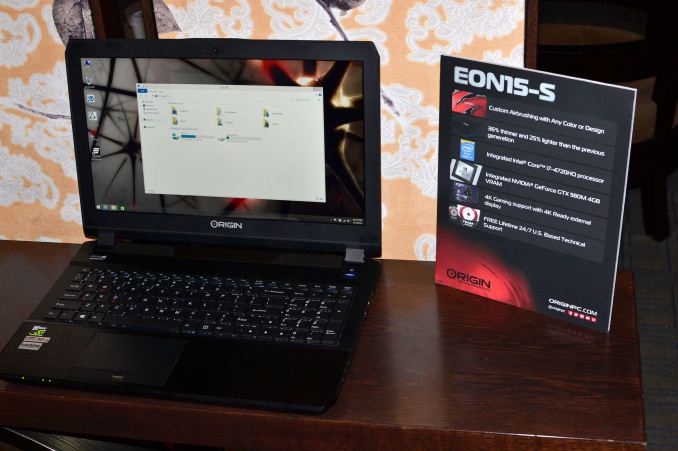
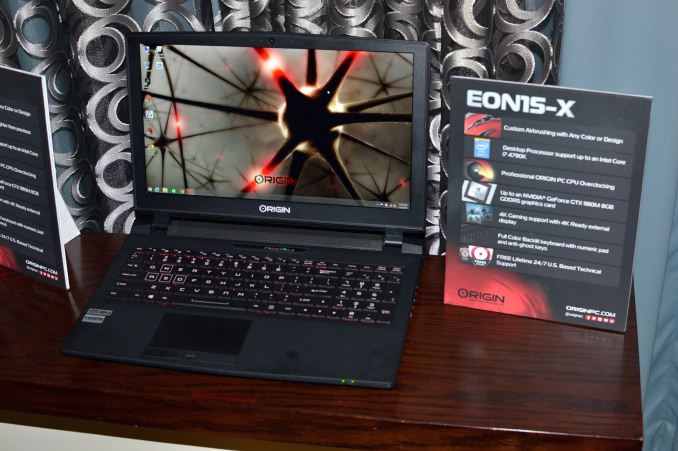
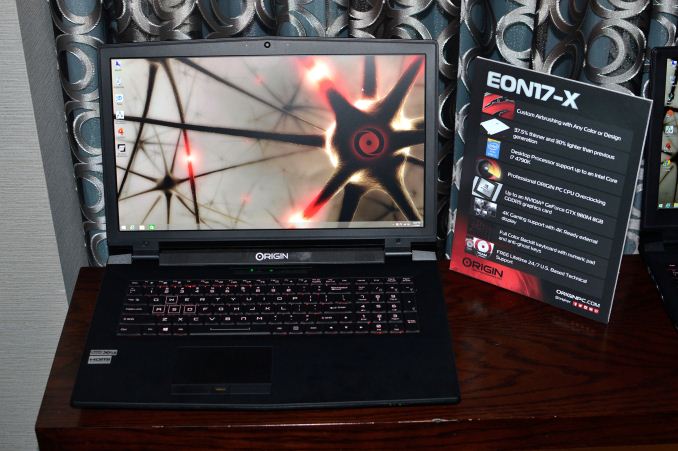
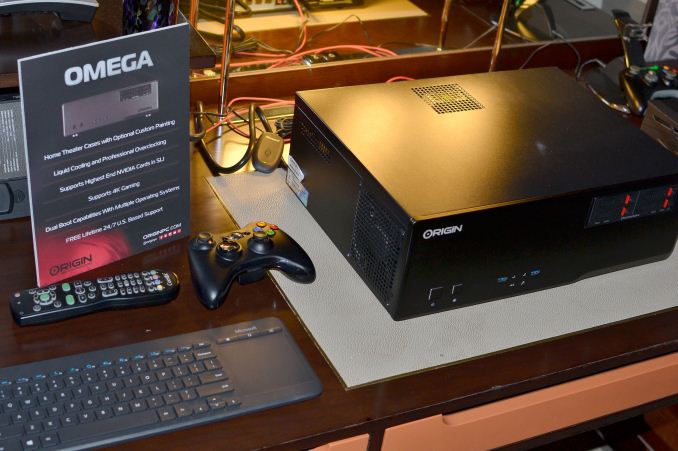














33 Comments
View All Comments
chizow - Wednesday, January 14, 2015 - link
Yes, that is exactly my point for why SteamOS was doomed to failure without strong impetus to adopo it, because HL3 excluded, SteamOS isn't compatible with the existing library of games many users have already built up. The "Killer App" to spur SteamOS adoption is HL3, without it, you are making my point for me.MTRougeau - Wednesday, January 14, 2015 - link
Right, but 10 years ago, what did Valve have to lose? Compared to today, not very much. Naturally, they are going to be more cautious about their decisions now than they were in the early days.HL3 exclusive on SteamOS would never happen, and if they tried it, they would pull a "Windows 10" and correct course quickly.chizow - Wednesday, January 14, 2015 - link
They faced similar risk, people not buying the game because they did not want to get tied to Steam, but as we can see, views on Steam have changed. Even if they staggered release of HL3 for SteamOS first, and later launched on other platforms, they would stand to gain on SteamOS adoption.What do they have to lose today? Valve hasn't derived much of its revenue in recent years from selling 1st party games anyways, as they've clearly shifted focus to software publishing now. If Newell's strategy is to leverage his 65-70 million Steam accounts as the start of a new gaming platform to rival consoles that he controls completely, risking HL3 sales and dealing with whatever associated ill will will mean little in the big picture.
MTRougeau - Wednesday, January 14, 2015 - link
Views on Steam have changed because Steam itself has changed. For many people, it adds so much value to their experience and asks very little in return. I suppose something similar could happen with SteamOS, but again, SteamOS is essentially Steam itself. Valve doesn't gain a ton from having users switch from Windows to SteamOS; they gain when someone uses Steam, regardless of platform. Perhaps they stand to gain in terms of hardware sales, but I really doubt it would be much compared to their software sales.What they have to lose today is not HL3 sales - it's those 60-75 million user accounts you mention. If Valve were to suddenly become "evil", well....things can change quickly. Valve has built up a huge store of good will with the PC community, because they've earned it. But change a few policies here, alter a few practices there, start acting more "selfish", and that goodwill can vanish. They stand to lose WAY more now than they did back in 2004.
chizow - Thursday, January 15, 2015 - link
I disagree, Steam adds convenience, that's it, when at first it was just an inconvenience. I see a similar shift in any digital distribution service/library system, same for Origin, Ubisoft or D2Drive/GF client. Sure its a PITA for 1 or 2 titles, but once you have that 1 killer app you have to have the client for anyways, it gradually becomes a similar convenience as Steam, since it is already a fact of life.Same for SteamOS. HL3 would just be a trojan to get SteamOS in your daily routine, same as HL2 was for Steam client. And they would gradually add to that, if they can.
And they would stand to gain on their own platform, because in reality, they would be able to control everything similar to the concerns about Windows Store. If everything goes through Steam Marketplace, they get a cut of everything. Its pretty obvious to me Steam is just reacting to the fact a ton of these AAA 1st party publishers like EA and Ubi realizing they can invest a few million on their own and bypass Steam because Windows is actually an open platform, contrary to some of the claims made here. SteamOS is their reaction and attempt to regain control of their ecosystem.
Also, I wouldn't underestimate the hardware angle, either, since that is clearly another revenue stream they can get a piece of that they get none of now. It might not eclipse their software business, but it they certainly stand to gain more than that they make now on hardware (nothing).
But those 60-75 million accounts aren't going anywhere, not anytime soon anyways. Everyone has a ton of steam games on their accounts at this point, so its safe to say Valve has you by the proverbial balls regardless of public perception and this won't change anytime soon.
MTRougeau - Thursday, January 15, 2015 - link
Eh, it's a bit more than convenience, though it certainly adds that. As the platform has grown, they've added VALUE. In game chat/browser, in home streaming, built in broadcasting, Steam trading, achievements, Big Picture mode, screenshots, guides, user reviews, custom curation, family sharing, "kids" mode, music playlists, Steam Community (basically a social network for PC games, etc. etc. The list goes on. There isn't a single distribution platform out there right that can compete with that feature list. It wasn't always like that, as I said, but as Steam has changed, views on Steam have changed.As far as Valve having lots to gain with SteamOS adoption, again, SteamOS is Steam in Big Picture mode running on Linux, nothing more. There are no features on SteamOS that aren't in the Steam Client itself. Valve profits when someone uses Steam, period. It doesn't matter if it's on Windows or on SteamOS, aside from the aforementioned hardware sales, which, again, would not be much. Valve is much more interested in getting users onto Steam, because that's where the money is for them. Therefore, they aren't going to charge a huge markup on hardware, which would discourage platform adoption. I see it as a similar strategy to Google with Android, where they essentially give away the software so long as the Play Store is on the device. Google exerts some control over Android, sure, but companies like HTC and Samsung completely re-do the UI, stock it with their own custom apps, etc. I think Valve is looking to do the same thing with SteamOS: let a bunch of different hardware manufacturers use the OS across and wide range of PC's, and may the best build win.
Lonyo - Tuesday, January 13, 2015 - link
There were SFF gaming PCs before Steam Machines "became" a "thing". Natural development of the industry overall that was occurring anyway.chizow - Tuesday, January 13, 2015 - link
There were SFF or LAN boxes that were small and portable sure, but they were also distinctly PCs in a shoebox, like the Shuttles of the world. Nothing like the revolution we have seen since Alienware's X51 (first Steam Box, even if unofficial) and the wave of very console-like SFFs that use a number of non-commodity, OEM, server, or even custom parts that have followed.Its obvious to me anyways, a lot of companies did their work with all the buzz around Steam Box and realized, hey, for $60 more, people are willing to buy this as a pretty kick-ass Windows Gaming PC. Oh, and it actually has games and ecosystem already developed, with a much better integrated controller system (XBox 360/One support) too!
Lonyo - Friday, January 16, 2015 - link
The X51 from January 2012, before Steam Box (or even Steam for Linux or Big Picture mode) existed? Or a different Alienware X51 from pre-Steam Box times? Which just proves my point.Unless the Alienware X51 was the first Steam Box "revolution" product which came out before the thing that caused the revolution. Which was entirely my point.
JeffFlanagan - Tuesday, January 13, 2015 - link
How would inexpensive Windows licenses make the Steam OS pointless? Cheap licenses do nothing to break Valve free from dependence on Microsoft, and we know that Microsoft is an extremely flaky company due to the Win ME and Win 8 fiascoes.